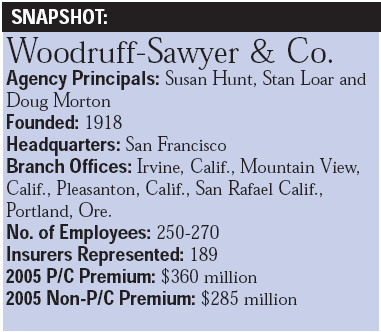Knowing how to make a business better and more successful is something every business owner struggles with. Defining a successful company’s best practices can provide a framework on what to do to become successful and even more importantly, what not to do.
Best Practices is a new Insurance Journal column that aims to get at the heart of how some of the nation’s top performing agencies run their operations. IJ’s Publisher, Mark Wells, met up with Stan Loar, CEO of the San Francisco-based Woodruff-Sawyer & Co., one of the most successful agencies in the country, to discuss his company’s secret to success.
Mark Wells: Stan, give our readers sort of a snapshot view of Woodruff-Sawyer.
Stan Loar: Woodruff-Sawyer was founded in 1918, so we have a long history of serving the Bay Area, California, community. We are basically a firm that is focused primarily on large retail, high accounts, large public companies, large contractors; we do not really focus on either Main Street or personal lines. We are an ESOP since 1995 and have about 260 or 270 employees today.
Wells: When you talk about the types of accounts, is there any one niche you seem to specialize in?
Loar: Basically, what we are servicing and what we are most successful in is the technology arena. We’re extremely successful in the construction arena, and that is pretty much throughout the state. We’ve got some very large contractors both in California and Oregon. We are successful in basic manufacturing. We have some large smelters. We have some very large professional organizations. We have a lot of retail accounts throughout the states and have been very successful there. We have a unique practice in management liability. We are quite large and we service accounts on the East Coast, in Texas and wherever for management liability needs.
Wells: You mention an ESOP. Let’s talk a little about that … it’s an employee ownership vehicle.
Loar: We began in 1994 on the study and implementation of an employee stock option plan. The reason we did that was to help perpetuate ourselves. In doing so, we have moved roughly 30 percent of our corporations’ ownership into this ESOP. The ESOP holds the shares for all of the employees. Once you meet a term of minimum employment at Woodruff-Sawyer, every employee is eligible to be part of that.
Wells: What would you say is the one thing that is responsible for the success of Woodruff-Sawyer?
Loar: I think it really gets back to the people. Finding, hiring and retaining, and obviously in the meantime, motivating good people are where it’s at.
Wells: Tell us what some of your bigger mistakes might have been and what did you learn from those.
Loar: Well, I’d like to think we’ve never make a mistake, but everybody falls off the wagon, so to speak and gets off-track. I think where we’ve got off-track is where we’ve been internally focused and not focused on our clients and our employees.
Happy employees are going to perform better and provide better service to our clients. Staying client-focused is absolutely paramount. But if we’ve made any mistakes, it’s that we would be internally focused on systems and procedures, and not stay focused on the clients.
Wells: If you could start over again, would you do anything differently?
Loar: I’d hire more good people. But the problem with that is that there are a lot of good people out there, but it takes time to find out and select, and get the right ones on board. There are a lot of good people that don’t fit with our culture and the way we want to do business. So getting the right people, not only good people, but the right people, on board, and motivated is the key.
Wells: Where do you find your people?
Loar: In addition to the traditional approach of looking within the industry, we have taken the approach of both looking outside the industry, i.e., those people who may be in accounting or have been selling something other than insurance, and bring them in and teach them the business.
The other approach is hiring what I will call young people, meaning either college graduates or people with one to four years of experience in some other industry. We’ve hired a bunch of these types and had incredibly great success in terms of retention, adding energy to the organization, and really creating the next wave of impact players within our organization.
Wells: What would be your advice to your fellow brokers that are in the early stages of building their agency?
Loar: Build an agency that’s going to grow and prosper and perpetuate itself. There are many agencies that grow and do not perpetuate. Growing and nurturing that agency and making sure that it stays independent for the benefit of the employees, the benefit of the clients. [That] really requires spreading the ownership around. Having a nice sized piece of a very large pie is much better than having a great big piece of a little tiny pie. I think sharing the wealth and involving others in ownership and responsibility is a good thing, and you will get the dividends from doing that if you get the right people and motivate them and train them in the right way. This is the only way that an agency principal can leverage themselves.
Wells: And I understand that Woodruff-Sawyer has kind of an unusual position on broker remuneration or profit sharing plans. Can you share some of your thoughts about that? It’s kind of a hot and volatile topic right now in the industry.
Loar: Mark, you’re right. It is a volatile and much discussed situation. The stance at Woodruff-Sawyer was taken about 16 months ago. We decided to give up profit sharing and step back from the old, traditional approach to profit sharing arrangements or incentives that were coming under scrutiny by the attorneys general and inspectors in some of the departments of insurance. The reason we did that, primarily, was not that we were in trouble or had a gun to our head like some of the publicly traded companies, but more like it was a style issue, an efficiency issue, and we wanted to make sure that we are able to communicate complete and open disclosure without the impediments of this overhanging profit sharing arrangement, which is not always easy to communicate and describe to outsiders. We were going to tell our clients exactly what our compensation was for every transaction.

Was this article valuable?
Here are more articles you may enjoy.


 Survey Shows Majority of Florida, California Homeowners Seeing Higher Insurance Costs
Survey Shows Majority of Florida, California Homeowners Seeing Higher Insurance Costs  AIG General Insurance Chairman McElroy to Retire May 1
AIG General Insurance Chairman McElroy to Retire May 1  Uncertainty Keeps Prices Up; No Prior-Year Loss Development: Travelers
Uncertainty Keeps Prices Up; No Prior-Year Loss Development: Travelers  Chubb to Acquire MGA Healthy Paws From Aon
Chubb to Acquire MGA Healthy Paws From Aon 


